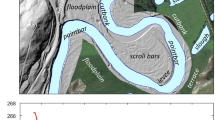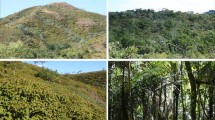Abstract
Riparian forests are highly valued for maintaining water quality through the retention of sediments and nutrients. They also provide some of the most diverse and species-rich habitats in the world. What is largely unknown, however, is how sediment deposition affects plant community composition in these forests. The objective of this study was to examine changes in plant community composition across a gradient of increasing rates of sedimentation in riparian forests in the southeastern Coastal Plain, USA. Seventeen plots were established within riparian forests receiving between 0 and 5.5 cm year−1 of sediment deposits. Species density and biomass estimates were collected annually from 2002 to 2006 for overstory and mid-story plant species within each plot. Percent cover and nested frequency of understory plant species were determined annually during 2004–2006. Measures of community composition in the understory, mid-story, and overstory layers of forests were compared to changes in environmental factors associated with increased sedimentation. In the understory, annual, exotic, and upland species had higher importance values in plots receiving high sediment deposition. The densities of shade-intolerant and N-fixing species in the mid-story also increased with increasing sedimentation rates. Increased overstory mortality was associated with high sedimentation rates, though increases in understory light levels in these gaps were not the main driver of understory species changes. Edaphic factors, such as soil texture, moisture, and temperature, were significantly correlated to species composition in all three forest layers, suggesting that changes in soil physical structure due to sedimentation may drive community-level changes in these forests.








Similar content being viewed by others
References
Barbour MG, Burk JH, Pitts WD, Gilliam FS, Schwartz MW (1998) Terrestrial plant ecology. Benjamin Cummings/Addison Wesley Longman, Inc., Menlo Park
Barry MJ, Bowers R, De Szalay FA (2004) Effects of hydrology, herbivory and sediment disturbance on plant recruitment in a Lake Erie coastal wetland. Am Midl Nat 151:217–232
Bonis A, Lepart J (1994) Vertical structure of seed banks and the impact of depth of burial on recruitment in two temporary marshes. Vegetation 112:127–139
Cassman KG, Munns DN (1980) Nitrogen mineralization as affected by soil-moisture, temperature, and depth. Soil Sci Soc Am J 44:1233–1237
Cavalcanti GG, Lockaby BG (2006) Effects of sediment deposition on aboveground net primary productivity, vegetation composition, and structure in riparian forests. Wetlands 26:400–409
Chen TH, Chiu CY, Tian GL (2005) Seasonal dynamics of soil microbial biomass in coastal sand dune forest. Pedobiologia 49:645–653
Clark AP, Phillips DR, Frederick DJ (1985) Weight, volume, and physical properties of major hardwood species in the Gulf and Atlantic Coastal Plains. USDA Forest Service, Southeastern Forest Experimental Station, Research paper 250, Asheville
Cooper JR, Gillian JW, Daniels RB, Robarge WP (1987) Riparian areas as filters for agriculture sediment. Soil Sci Soc Am J 51:416–420
Daubenmire R (1959) A canopy-coverage method of vegetation analysis. Northwest Sci 33:43–64
Dech JP, Maun MA (2006) Adventitious root production and plastic resource allocation to biomass determine burial tolerance in woody plants from central Canadian coastal dunes. Ann Bot 98:1095–1105
Decocq G (2002) Patterns of plant species and community diversity at different organization levels in a forested riparian landscape. J Veg Sci 13:91–106
Dittmar LA, Neely RK (1999) Wetland seed bank response to sedimentation varying in loading rate and texture. Wetlands 19:341–351
Elliot KJ, Boring LR, Swank WT, Haines BR (1997) Successional changes in plant species diversity and composition after clearcutting a Southern Appalachain watershed. For Ecol Manag 92:67–85
Fisher RF, Binkley D (2000) Ecology and management of forest soils. Wiley, New York
Franks SJ, Peterson CJ (2003) Burial disturbance leads to facilitation among coastal dune plants. Plant Ecol 168:13–21
Gee GW, Bauder JW (1986) Particle size analysis. In: Klute A (ed) Methods of soil analysis, part 1, physical and mineralogical methods, agronomy monograph no 9. American Society of Agronomy, Madison, pp 383–411
Gilliam FS, Turril NL, Adams MB (1995) Herbaceous-layer and overstory species in clear-cut and mature central Applalachain hardwood forests. Ecol Appl 5:947–955
Gleason RA, Euliss NH, Hubbard DE, Duffy WG (2003) Effects of sediment load on emergence of aquatic invertebrates and plants from wetland soil egg and seed banks. Wetlands 23:947–955
Grime JP (1973) Control of species density on herbaceous vegetation. J Environ Manag 1:151–167
Grime JP (2002) Declining plant diversity: empty niches or functional shifts? J Veg Sci 13:457–460
Guo D, Mou P, Jones RH, Mitchell RJ (2002) Temporal changes in spatial patterns of soil moisture following disturbance: an experimental approach. J Ecol 90:338–347
Halpern CB, Spies TA (1995) Plant-species diversity in natural and managed forests of the Pacific-Northwest. Ecol Appl 5:913–934
Harper JL (1977) Population biology of plants. Academic Press, London
Hart SC, Stark JM, Davidson EA, Firestone MK (1994) Nitrogen mineralization, immobilization, and nitrification. In: Bottomley PS (ed) Methods of soil analysis. SSSA, Madison, pp 985–1018
He MZ, Zheng JG, Li XR, Qian YL (2007) Environmental factors affecting vegetation composition in the Alxa Plateau, China. J Arid Environ 69:473–489
Heimann DC, Roell MJ (2000) Sediment loads and accumulation in a small riparian wetland system in northern Missouri. Wetlands 20:219–231
Hodges JD (1997) Development and ecology of bottomland hardwood sites. For Ecol Manag 90:117–125
Howard LF, Lee TD (2003) Temporal patterns of vascular plant diversity in southeaster New Hampshire forests. For Ecol Manag 185:5–20
Hupp CR, Bazemore DE (1993) Temporal and spatial patterns of wetland sedimentation, West Tennessee. J Hydrol 141:179–196
Hupp CR, Morris EE (1990) A dendrogeomorphic approach to measurement of sedimentation in a forested wetland, Black Swamp, Arkansas. Wetlands 10:107–124
Hupp CR, Woodside MD, Yanosky TM (1993) Sediment and trace element trapping in a forested wetland, Chickahominy River, Virginia. Wetlands 13:95–104
Hupp CR, Demas CR, Kroes DE, Day RH, Doyle TW (2008) Recent sedimentation patterns within the central Atchafalaya Basin, Louisiana. Wetlands 28:125–140
Ito H, Ito S, Matsui T, Marutani T (2006) Effects of fluvial and geomorphic disturbances on habitat segregation of tree species in a sedimentation-dominated riparian forest in warm-temperate mountainous region of southern Japan. J For Res 11:405–417
Jolley RL, Lockaby BG, Cavalcanti GG (2009) Productivity of ephemeral headwater riparian forests impacted by sedimentation in the southeastern United States coastal plain. J Environ Qual 38:965–979
Jolley RL, Lockaby BG, Governo RM (2010) Biogeochemical influences associated with sedimentation in riparian forests of the Southeastern Coastal Plain. Soil Sci Soc Am J 74:326–336
Jones RH, Sharitz RR, Dixon PM, Segal DS, Scheider RL (1994) Woody plant regeneration in four floodplain forests. Ecol Monogr 64:345–367
Jurik TW, Wang SC, Valk vd (1994) Effects of sediment load on seedling emergence from wetland seed banks. Wetlands 14:159–165
Kent M, Owen NW, Dale P, Newnham RM, Giles TM (2001) Studies of vegetation burial: a focus for biogeography and biogeomorphology? Progr Phys Geogr 25:455–482
Kent M, Owen NW, Dale MP (2005) Photosynthetic responses of plant communities to sand burial on the Machair dune systems of the Outer Hebrides, Scotland. Ann Bot 95:869–877
Kleiss BA (1996) Sediment retention in a bottomland hardwood wetland in eastern Arkansas. Wetlands 16:321–333
Koning CO (2004) Impacts of small amounts of sandy sediment on wetland soils and vegetation: results from field and greenhouse studies. Wetlands 24:295–308
Leendertse PC, Roozen AJM, Rozema J (1997) Long-term changes (1953–1990) in the salt marsh vegetation at the Boschplaat on Terschelling in relation to sedimentation and flooding. Plant Ecol 132:49–58
Levine CM, Stromberg JC (2001) Effects of flooding on native and exotic plant seedlings: implications for restoring south-western riparian forests by manipulating water and sediment flows. J Arid Environ 49:111–131
Lyon J, Gross NM (2005) Patterns of plant diversity and plant–environmental relationships across three riparian corridors. For Ecol Manag 204:267–278
Lyon J, Sagers CL (2003) Correspondence analysis of functional groups in a riparian landscape. Plant Ecol 164:171–183
Mahaney WM, Wardrop DH, Brooks RR (2004) Impacts of stressors on the emergence and growth of wetland plant species in Pennsylvania, USA. Wetlands 24:538–549
McCune B, Antos JA (1981) Correlations between forest layers in the Swan Valley, Montana. Ecology 62:1196–1204
McCune B, Mefford MJ (1999) PC-ORD. MjM Software Design, Gleneden Beach
Moore MR, Vankat JL (1986) Responses of the herb layer to the gap dynamics of a mature beech-maple forest. Am Midl Nat 115:336–347
Naiman RJ, Decamps H (1997) The ecology of interfaces: riparian zones. Ann Rev Ecol Syst 28:621–658
Odland A, Moral RD (2002) Thirteen years of wetland vegetation succession following permanent drawdown, Myrkdalen Lake, Norway. Plant Ecol 162:185–198
Olde Venterink H, Vermaat JE, Pronk M, Wiegman F, van der Lee GEM, van den Hoorn MW, Higler L, Verhoeven JTA (2006) Importance of sediment deposition and denitrification for nutrient retention in floodplain wetlands. Appl Veg Sci 9:163–174
Perumal VJ, Maun MA (2006) Ecophysiological response of dune species to experimental burial under field and controlled conditions. Plant Ecol 184:89–104
Peterson JE, Baldwin AH (2004) Seedling emergence from seed banks of tidal freshwater wetlands: response to inundation and sedimentation. Aquat Bot 78:243–254
Peterson DL, Rolfe GL (1982) Nutrient dynamics of herbaceous vegetation in upland and floodplain forest communities. Am Midl Nat 107:325–339
Petru M, Menges ES (2004) Shifting sands in Florida scrub gaps and roadsides: dynamic microsites for herbs. Am Midl Nat 151:101–113
Pinay G, Ruffinoni C, Fabre A (1995) Nitrogen cycling in two riparian forest soils under different geomorphic conditions. Biogeochemistry 30:9–29
Pregitzer KS, Barnes BV (1982) The use of ground flora to indicate edaphic factors in upland ecosystems of the McCormick Experimental Forest, Upper Michigan. Can J For Res 12:661–672
Radford AE, Ahles HA, Bell CR (1968) Manual of the vascular flora of the carolinas. The University of North Carolina Press, Chapel Hill
Rybczyk JM Jr, Day JW, Conner WH (2002) The impact of wastewater effluent on accretion and decomposition in a subsiding forested wetland. Wetlands 22:18–32
SAS-Institute (2002–2003) SAS 9.1. SAS Institute, Cary
Ter-Mikaelian MT, Korzukhin MD (1997) Biomass equations for sixty-five North American tree species. For Ecol Manag 97:1–24
USDA (2008) The PLANTS database. National Plant Data Center, Baton Rouge. www.PLANTS.USDA.gov. Accessed 15 Feb 2005
van der Valk AG, Swanson SD, Nuss R (1983) Response of plant species to burial in three types of Alaskan wetlands. Can J Bot 61:1150–1164
Walls RL, Wardrop DH, Brooks RP (2005) The impact of experimental sedimentation and flooding on the growth and germination of floodplain trees. Plant Ecol 176:203–213
Wardrop DH, Brooks RR (1998) The occurrence and impact of sedimentation in central Pennsylvania wetlands. Environ Monit Assess 51:119–130
Welling CH, Becker RL (1990) Seed bank dynamics of Lythrum salicaria L.: implications for control of this species in North America. Aquat Bot 38:303–309
Werner KJ, Zedler JB (2002) How sedge meadow soils, microtopography, and vegetation respond to sedimentation. Wetlands 22:451–466
Wilson AD, Shure DJ (1993) Plant competition and nutrient limitation during early succession in the Southern Appalachian Mountains. Am Midl Nat 129:1–9
Zenner EK, Kabrick JM, Jensen RG, Peck JE, Grabner JK (2006) Responses of ground flora to a gradient of harvest intensity in the Missouri Ozarks. For Ecol Manag 222:326–334
Zheng YR, Xie ZX, Yu Y, Jiang LH, Shimizu H, Rimmington GM (2005) Effects of burial in sand and water supply regime on seedling emergence of six species. Ann Bot 95:1237–1245
Acknowledgments
This research was supported by funding from the US DoD/EPA/DoE under the Strategic Environmental Research and Development Program (no. UT-B-4000010718; SERDP, www.serdp.org). We thank the SERDP Ecosystem Management Project personnel at the Fort Benning Military Reservation for access to study sites, and Hugh Westbury for logistical support. We thank Robin Governo and Lena Polyakova for lab assistance, and Don Vestal, Erik Schilling, Pedro Simoes, Jonathon Palmer, LaTasha Folmar, Adam Taylor, Brady Memmott, John Dow, Trae Compton, Emile Elias, Jackie Crim, Jennifer Mitchell, Eve Brantley, Chris Anderson, and Felipe Casarim for field assistance. We thank Michele Burton for help with statistical analysis and Gary Ervin, as well as two anonymous reviewers, for their comments and suggestions in earlier versions of this manuscript.
Author information
Authors and Affiliations
Corresponding author
Rights and permissions
About this article
Cite this article
Jolley, R.L., Lockaby, B.G. & Cavalcanti, G.G. Changes in riparian forest composition along a sedimentation rate gradient. Plant Ecol 210, 317–330 (2010). https://doi.org/10.1007/s11258-010-9759-0
Received:
Accepted:
Published:
Issue Date:
DOI: https://doi.org/10.1007/s11258-010-9759-0




